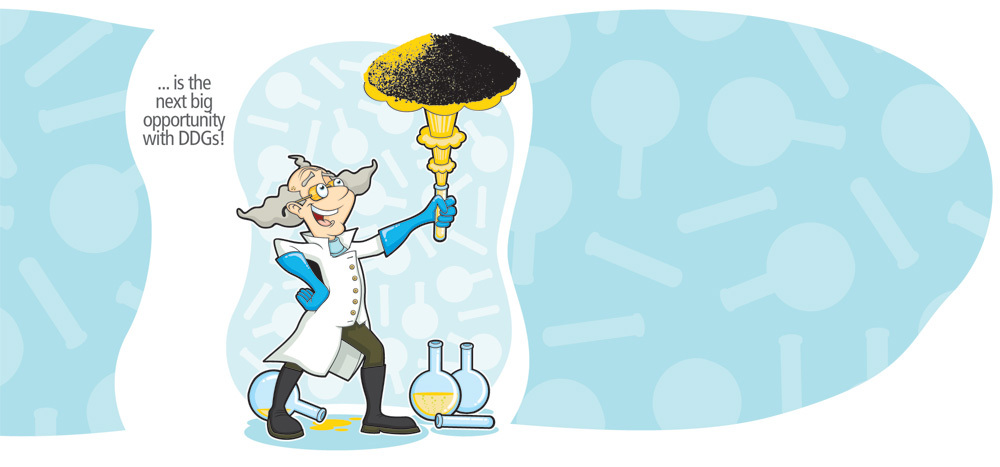Customized Coproducts Needed as Industry Matures



June 6, 2011
BY Joseph Riley
As we continue to see maturation in the distillers grain industry, the impact of corn oil is gaining momentum. In 2006, there were only four dry mill ethanol plants extracting corn oil from their process, and oil values were in the 12 to 15 cents-per-pound range. Contrast that with this April, when there were about 50 plants extracting oil at a value approaching 50 cents per pound. While food-grade corn oil has been a kitchen staple around the world for many years, the use of nonfood-grade corn oil was uncertain at best in the first few years of extraction.
With five years of experience, the current market for this corn oil is maturing at a rapid rate. Whereas initial deliveries of this oil were predominately into the animal feed market, we now see a significant portion being used at biodiesel facilities across the Midwest. The 2011 resurgence of biodiesel has nearly doubled the value of extracted oil, though what will happen after the expiration of the tax credits for biodiesel in December is unknown. With almost 20 percent of plants extracting corn oil (with many estimates showing up to 40 percent by the end of 2011, and 55 percent by the end of 2012), the normal DDG variability has dramatically increased to a point that the product may be considered unmanageable by some animal nutritionists. This variability is the largest reason why DDGs have been consistently undervalued compared to competing feed ingredients.
Most plants sell their DDGs as they come out, purchased by the closest livestock producer or facility that will take them, pricing the DDGs based on a market price that day. In short, ethanol producers are giving livestock producers a reason to call DDGs a by-product and place it in the “commodity” category.
Advertisement
As many industries such as food processors and petroleum have shown in the past, individual component values are significantly higher than the value of a combined stream. While past performance cannot dictate future results, the goal should be that DDG value be maximized by splitting the individual constituents of DDGs into purified streams. Most of this cannot be accomplished with existing processing and infrastructure, but corn oil extraction can be the first step in accomplishing this goal.
While many facilities have been able to extract oil without having to discount their DDG price, this phenomenon will likely end in the near future. With the maturation of the DDG feed market, many consumers are becoming more aware of the value, and will likely demand discounts with reduced oil levels. This doesn’t mean that oil extraction should be left by the roadside. Instead, corn oil extraction should be strategic to the customer served by each individual plant. With the high density of plants within the Upper Midwest, the issue inhibiting a differentiated product mentality is customer defection. The commodity mentality has created a mental model with our customers that one plant’s product is the same as another. So if one seemingly reduces its value by extracting oil, they will immediately defect to the next plant in line. Most ethanol plants sit idly by while this happens.
In reality, not all livestock producers require the same DDG components. Hog producers prefer DDGs with less corn oil to reduce the softness of fat in the belly and jowl and also see the value of the energy component as a positive attribute. One ethanol facility recently lost a local customer for DDGs when it began extracting corn oil. It turned to a lower-value export market. Yet the value of the oil was far higher than the difference between local and export markets. Meanwhile, a hog producer up the road had just removed DDGs from its ration. The high level of corn oil they were receiving in the DDG from another ethanol plant was causing the packer to discount their hogs because of soft belly fat.
Advertisement
With tightening margins within ethanol production, the producers need to reconsider their mental model of profitability. Instead of focusing 95 percent of their energy on alcohol production, they need to focus on being a true biorefinery. There are enormous opportunities to create custom products to meet customer demands, but existing plants have limited process control outside of alcohol production. This is the root cause of variability in DDG composition and quality, and until more measurement is completed, there will not be significant improvements. With increased process measurements and control, the probability of producing a higher value product is vastly improved. What is difficult to communicate and grasp is the fact that there is no “right” product out of the ethanol coproduct stream. By understanding what causes the nutritional variability in their own DDGs, a plant can identify methods to reduce this variability, thereby contributing to a higher value product stream. This would help a facility to recapture whatever value is lost in the “as-shipped” DDGs due to corn oil extraction, and still capture the full value of extracted oil.
While the majority of ethanol plants are centrally located geographically, the opportunity for these plants to service dramatically different customers is available. In an ideal world, an ethanol plant would have 15 individual product streams that would enable facilities to custom blend individual loads based on customer demand. The mentality of one-size-fits-all DDGs needs to be banished from the industry, and the commoditization mantra needs to be eliminated. There will likely never be consensus among animal nutritionists on what the ideal composition of DDGs for feeding is, even within one animal group. Ethanol plants need to produce what their customers want instead of just providing them with whatever is pushed out the backside of the plant. With increased segregation of constituents, the ability to custom blend can be presented to customers. This will maximize value to the plant and to its customers.
There are several companies working to re-engineer DDGs to achieve a higher value, more consistent and specifically tailored DDG. If the ethanol industry looks to food processing as its model, it will see that as markets mature, a purified stream has become more valuable than a mixed stream. This is true because it allows for flexibility, manageability, marketability and most importantly, customization. Livestock producers would, understandably, much rather take the constituents of DDGs supplied at their local ethanol facility and formulate a ration that is best for the species, the season and the system employed.
FEC Solutions, founded in 2006, provides innovative corn oil marketing solutions as well as a market for fats and oils for specialty processing. The aim of FEC Solutions is to provide solutions to the biofuels industry which enhance ethanol producer margins and promote stability and consistency in the marketplace for livestock nutrition products.
Author: Joseph Riley
Cofounder and General Manager, FEC Solutions
jpriley@fecsolutions.com
Upcoming Events





